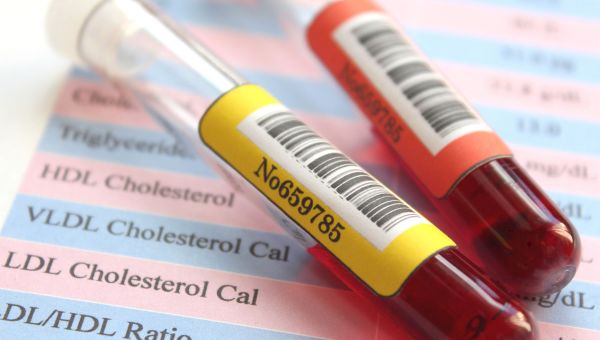6 numbers women should know for heart health
Heart disease is a leading killer of women. Tracking these numbers could potentially save your life.
Updated on March 11, 2024

In years past, it was commonly assumed that heart disease affected men more than women. But that's not the case. In fact, heart disease is the leading killer of men and women in the United States, responsible for one in every five deaths.
The most common form is coronary artery disease (CAD). When you have CAD, the arteries that supply blood to your heart become hardened… Show More
In years past, it was commonly assumed that heart disease affected men more than women. But that's not the case. In fact, heart disease is the leading killer of men and women in the United States, responsible for one in every five deaths.
The most common form is coronary artery disease (CAD). When you have CAD, the arteries that supply blood to your heart become hardened or blocked. CAD affects between 6 and 7 percent of women in the U.S.
Ignoring the risk of heart disease can be dangerous. But learning and keeping track of certain key heart health numbers can help you protect yourself. Here are the six most important to know.
Show Less
Blood pressure range
High blood pressure can increase your risk for stroke, heart attack, heart failure, kidney failure, dementia (a brain condition that causes problems with memory, language, and thinking), vision loss, and sexual issues. A blood pressure reading at or above 130 mm Hg systolic (top number) or 80 mm Hg… Show More
High blood pressure can increase your risk for stroke, heart attack, heart failure, kidney failure, dementia (a brain condition that causes problems with memory, language, and thinking), vision loss, and sexual issues. A blood pressure reading at or above 130 mm Hg systolic (top number) or 80 mm Hg diastolic (bottom number) is considered high. If your systolic reading is between 120 and 129 and your diastolic number is less than 80, your blood pressure is considered elevated.
Since high blood pressure is usually symptomless, regular screenings are important. Beginning at age 18, people with normal blood pressure (less than 120/80 mm Hg) should be checked regularly. If your blood pressure is higher than normal, you may be screened more frequently.
Blood pressure levels are affected by:
- Age
- Sex
- Family history
- Race
- Weight
- Habits such as eating an unhealthy diet, not getting enough exercise, smoking, and drinking alcohol in excess
- Health conditions such as diabetes and high cholesterol (a type of fat in the blood)
- Pain
- Emotional distress
- Pregnancy
- Chronic kidney disease

Total blood cholesterol levels
Cholesterol is a waxy, fat-like substance produced and used by the body to build cells. Cholesterol itself isn't bad—but too much cholesterol can be. It can contribute to the narrowing of your arteries, increasing your risk of heart attack and stroke over time.
The American Heart Association… Show More
Cholesterol is a waxy, fat-like substance produced and used by the body to build cells. Cholesterol itself isn't bad—but too much cholesterol can be. It can contribute to the narrowing of your arteries, increasing your risk of heart attack and stroke over time.
The American Heart Association recommends that beginning at age 20, adults have their cholesterol levels checked every four to six years. You may have to go more frequently if you’re at risk for heart disease or have already been diagnosed.
Show Less
High-density lipoprotein (LDL) levels
Total cholesterol is just one way to measure cholesterol levels. Blood tests can also measure your levels of high-density lipoprotein (HDL, also known as “good” cholesterol) and low-density lipoprotein (LDL, or “bad” cholesterol).
HDL cholesterol helps carry LDL cholesterol out of the arteries and… Show More
Total cholesterol is just one way to measure cholesterol levels. Blood tests can also measure your levels of high-density lipoprotein (HDL, also known as “good” cholesterol) and low-density lipoprotein (LDL, or “bad” cholesterol).
HDL cholesterol helps carry LDL cholesterol out of the arteries and back to the liver, preventing a buildup in the arteries. In general, the higher your HDL reading, the better. An HDL reading greater than or equal to 60 mg/dL is considered optimal. For women, levels below 50 mg/dL are less than desirable.
Show Less
Low-density lipoprotein (LDL) levels
LDL cholesterol is the primary source of buildup in your arteries. LDL readings help inform treatment, so knowing them is important. Optimal levels are below 100 mg/dL. Levels above 190 mg/dL are considered very high. According to 2018 guidelines, anyone with readings above this threshold will… Show More
LDL cholesterol is the primary source of buildup in your arteries. LDL readings help inform treatment, so knowing them is important. Optimal levels are below 100 mg/dL. Levels above 190 mg/dL are considered very high. According to 2018 guidelines, anyone with readings above this threshold will likely be prescribed a statin, a medication that helps lower cholesterol levels. Even if your LDL is under 190 mg/dL, you may still receive a statin depending on certain factors—including your age group, heart disease risk, and whether you have diabetes (high blood sugar levels).
Show Less
Blood sugar levels
Diabetes and prediabetes are risk factors for heart disease. When you have diabetes, it affects the way your body uses glucose, or blood sugar. Beginning at age 45, you should have your blood sugar levels checked every three years. If you are overweight or have high blood pressure, your doctor may… Show More
Diabetes and prediabetes are risk factors for heart disease. When you have diabetes, it affects the way your body uses glucose, or blood sugar. Beginning at age 45, you should have your blood sugar levels checked every three years. If you are overweight or have high blood pressure, your doctor may recommend earlier or more frequent screenings. There are a number of different tests, including:
- Hemoglobin A1C test: This blood test measures average blood sugar levels over a two- to three-month period. Levels below 5.7 are considered normal. A reading between 5.7 and 6.4 indicates prediabetes, and a reading of 6.5 or higher on two separate tests may signify diabetes.
- Random blood sugar test: For this test, a blood sample is taken at a random time. Levels of 200 mg/dL or above suggest diabetes and further testing should be done.
- Fasting blood sugar test: This blood sample is taken after an overnight fast, after having not eaten since the night before. Levels below 100 mg/dL (5.6 mmol/L) are normal, and between 100 and 125 mg/dL (5.6 to 6.9 mmol/L) indicate prediabetes. If your fasting blood sugar levels are 126 mg/dL (7 mmol/L) or greater on two tests, you will likely be diagnosed with diabetes.

Body mass index
Body mass index (BMI) is a rough indicator of the amount of fat on a person's body. It’s an imperfect measurement, since it doesn’t distinguish fat mass from muscle mass. BMI is calculated based on your height and weight, and can be accurately measured by your healthcare provider.
A normal or… Show More
Body mass index (BMI) is a rough indicator of the amount of fat on a person's body. It’s an imperfect measurement, since it doesn’t distinguish fat mass from muscle mass. BMI is calculated based on your height and weight, and can be accurately measured by your healthcare provider.
A normal or healthy BMI falls between 18.5 and 24.9. A body mass index between 25 and 29.9 is considered overweight. Anything 30 and above is deemed obese.
Being underweight or overweight can increase the risks for heart disease. Obesity is also a risk factor for other conditions, such as diabetes (high blood sugar levels), arthritis (inflammation of the joints), lung problems, liver disease, and some cancers.
Show Less
Boost your heart health
You can’t change certain risk factors for heart problems, such as your age and family history. But you can adopt healthy lifestyle habits that improve your blood pressure, blood sugar, cholesterol levels, and BMI. These include:
- Eating a well-balanced diet. Focus on healthy foods like fruit, … Show More
You can’t change certain risk factors for heart problems, such as your age and family history. But you can adopt healthy lifestyle habits that improve your blood pressure, blood sugar, cholesterol levels, and BMI. These include:
- Eating a well-balanced diet. Focus on healthy foods like fruit, vegetables, whole grains, low-fat dairy, and lean protein like chicken or turkey. Limit your intake of salt, added sugar, saturated fats that are solid at room temperature, and alcohol.
- Getting regular exercise. As you are able, shoot for at least 150 minutes of moderate-intensity activity like brisk walking or 75 minutes of vigorous activity like jogging or running each week.
- Maintaining a healthy weight. In addition to eating a healthy diet and getting regular exercise, reducing your overall calorie intake and better controlling portions can contribute to weight loss.
In many cases, your healthcare provider will prescribe medication to help keep your heart healthy, as well. Speak with your provider about the best heart health strategies for you.
Show Less
American Heart Association Go Red for Women. Common Myths About Heart Disease. Accessed October 22, 2020.
Centers for Disease Control and Prevention. Heart Disease: Women and Heart Disease. January 31, 2020.
MedlinePlus. Coronary Artery Disease. Accessed November 3, 2020.
Centers for Disease Control and Prevention. Heart Disease: Coronary Artery Disease (CAD). Page last reviewed July 19, 2021.
American Heart Association. Understanding Blood Pressure Readings. Accessed November 3, 2020.
PK Whelton, RM Carey, et al. 2017 ACC/AHA/AAPA/ABC/ACPM/AGS/APhA/ASH/ASPC/NMA/PCNA Guideline for the Prevention, Detection, Evaluation, and Management of High Blood Pressure in Adults: A Report of the American College of Cardiology/American Heart Association Task Force on Clinical Practice Guideline. Hypertension. 2018;71:e13–e115.
Health.gov. Get Your Blood Pressure Checked. Content last updated July 15, 2022.
Mayo Clinic. Blood pressure test. May 27, 2022.
NIH: National Heart, Lung, and Blood Institute. High Blood Pressure: Causes and Risk Factors. Last updated on March 24, 2022.
Hamrahian SM, Falkner B. Hypertension in Chronic Kidney Disease. Adv Exp Med Biol. 2017;956:307-325.
M Shen, H Tan, et al. Trajectory of blood pressure change during pregnancy and the role of pre-gravid blood pressure: a functional data analysis approach. Scientific Reports. July 24, 2017. 7(1), 6227.
American Heart Association. Health Threats From High Blood Pressure. October 31, 2016.
American Heart Association. What is Cholesterol?
American Heart Association. How To Get Your Cholesterol Tested. March 22, 2019.
Mayo Clinic. HDL cholesterol: How to boost your 'good' cholesterol. October 24, 2018.
American Heart Association. HDL (Good), LDL (Bad) Cholesterol and Triglycerides. April 30, 2017.
MedlinePlus. Cholesterol Levels: What You Need to Know. Last updated October 2, 2020.
MedlinePlus. LDL: The “Bad” Cholesterol. Last updated October 2, 2020.
SM Grundy, NJ Stone, et al. AHA/ACC/AACVPR/AAPA/ABC/ACPM/ADA/AGS/APhA/ASPC/NLA/PCNA Guideline on the Management of Blood Cholesterol: A Report of the American College of Cardiology/American Heart Association Task Force on Clinical Practice Guidelines. Circulation. November 10, 2018. 139:e1082–e1143.
Harvard Health Publishing. Making sense of cholesterol tests. May 14, 2022.
National Lipid Association. 2018 Guideline on the Treatment of High Blood Cholesterol. 2018.
American Diabetes Association. Standards of Medical Care in Diabetes. Clin Diabetes 2020;38(1):10–38.
Cai X, Zhang Y, et al. Association between prediabetes and risk of all cause mortality and cardiovascular disease: updated meta-analysis. BMJ. 2020;370:m2297.
Centers for Disease Control and Prevention. Diabetes Tests. May 15, 2019.
Mayo Clinic. Diabetes. October 25, 2022.
U.S. Department of Health and Human Services. Physical Activity Guidelines for Americans. 2019.
Centers for Disease Control and Prevention. Vital Signs: Medical Complications of Obesity. August 3, 2010.
Centers for Disease Control and Prevention. Healthy Weight, Nutrition, and Physical Activity: About Adult BMI. September 17, 2020.
UCSF Health. Obesity Treatments. Accessed October 22, 2020.
More On


video

article


video


video


video
